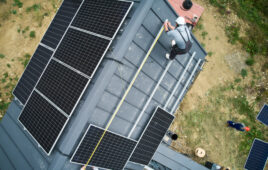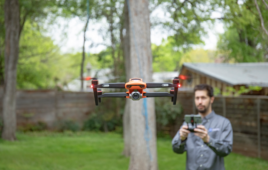
Key takeaway: A preliminary design typically informs an economic conversation during the sales process, while on-site data is essential for everything to follow. We recommend using a software that combines remote and on-site data to ensure accurate system sizing, production estimates, and hardware procurement.
Sales proposals almost always leverage data from satellite or remote imagery … but there’s a problem. Solar professionals overwhelmingly report satellite imagery is not entirely accurate and needs to be verified on-site.
However, just saying “satellite imagery is inaccurate” leads to other questions:
- What’s inaccurate about it? How accurate is “good enough”?
- What happens if I use inaccurate data?
- Why shouldn’t I use preliminary designs for installation planning?
- Can’t I just fix my layout on install day?
Why Having Both Preliminary and Final Designs Is Essential

When designing a solar array, three variables most impact a project’s success from the customer’s vantage point:
1. Sizing the System
Let’s say a sales rep can squeeze 20 panels on a roof in a preliminary proposal, based on a quick satellite snapshot. Since satellite data can have an inaccuracy delta of 10%+, the roof might only be able to hold 17 or 18 panels in the end—this is a significant change in electrical bill offset that could upset a customer.
Further, given the proliferation of simple quoting tools, the delta can be higher, let’s say 14 or 15 panels, making it a significant change in system size. Leveraging the preliminary design to inform an initial sales conversation, but following it up with a final layout using on-site data will avoid any missteps with the total panel count on install day.
2. Production Estimates (and Guarantees)
Inaccuracy from satellite imagery will also likely cause a production delta. Most preliminary designs miss obstructions, tree heights, or shading implications. This means even if a panel will fit in a specific section of the roof, it might actually be partially or fully covered, affecting production more than expected. This would upset the homeowner, and yield further trouble if there is a production guarantee.
To compensate for a delta in production, a Contractor may recommend upsizing the system. However, that could lead to a more expensive project, and the Contractor could have to foot the bill if there is a guarantee. Either way, this will damage a Contractor’s reputation.
Leveraging drone-based, photorealistic modeling tools and on-site shading analysis will resolve this issue. Production guarantee or not, Contractors never want to overpromise and underdeliver on the forecasted output of a system. There are few things a homeowner or property owner dislikes more than receiving a utility bill they didn’t expect after getting solar installed.

3. Hardware Procurement
From the quoting stages to install day, a lot can change. Notably, prices and supplies of hardware will swing, in some cases dramatically, changing the scope and cost of a project. Additionally, homeowners may want to change hardware (eg, panel size and color) to accommodate any aesthetic or structural preferences. Even if it’s only a few weeks between getting permits and finalizing a layout, that’s enough time for issues to arise. It’s helpful to have a rough estimate with a preliminary design, but to fine-tune it with on-site data so your hardware procurement process is as accurate as possible.
Advice for Contractors When Creating Preliminary Designs
While you should never rely solely on preliminary designs for installations, they still have their place in an efficient project workflow. Rolling a truck to verify a preliminary design can be costly and time-consuming. We advise doing this when it yields additional benefits in customer interactions, such as showing you put quality first, having a very interpersonal, “kitchen-table style” sales process, or as a closing mechanism. Using remote imagery is a useful estimate to inform your first few customer conversations and guides the economic dialogue of a solar array sale.
Therefore, when using preliminary designs in the sales process, there are a few strategies that work best:
First, set expectations. Explain to the customer that the layout is a quick preliminary design, but may not consider every small detail that could impact the system. Share how the preliminary design is meant to give homeowners an idea of what could be possible, but not guarantee anything—you’d need to verify on-site for that.
Next, explain the context, because a homeowner may wonder why you’re using a preliminary design if it isn’t fully accurate. It’s helpful to state that the first design is about getting them the information quickly and concisely, so they have a sense of the project details.
Lastly, follow up your preliminary stage with a comprehensive on-site survey that includes collecting full measurements, electrical and structural data, and shading analysis from the property. Educating the customer on how you will be finalizing the layout with comprehensive, real-time data from the field legitimizes your two-step design process as you go from prelim to engineering documents. We advocate doing surveys with the latest technology – a drone and mobile app – which doubles down on showing a customer you have a thorough process.
The Optimal Solution: Centralize Remote and On-site Data On One Platform
Unfortunately, many Contractors are stuck with multiple software, especially design-related tools for Prelim and Final designs. Most have similar data sources, features, and claims of offering “perfectly accurate” final layouts. Sadly, the nuances between these tools, especially Prelim ones, are becoming increasingly diluted. The tools are more or less the same. Further, Contractors are often stuck transferring data – manually or automatically through APIs – between their ecosystem of software products.

Good news for contractors. Platforms like Scanifly now enable you to combine the speed of a remote design with the precision of a drone-based final layout in one place. No more toggling between or paying for multiple tools to get the highest level of accuracy.
Having your preliminary and final designs in one platform lets you centralize all your field data in one spot, alongside your design information. When paired with a holistic, ideally drone-based, site assessment, this approach maximizes the chance for a perfectly accurate final design, production forecast, and hardware order. All this makes your pre-install process as realistic as possible, showcasing to the customer what a tech-enabled and quality first process looks like.
Own the Design to Own the Customer Relationship
Whether a Contractor does its own sales or buys leads from a sales-only outfit, the reality is doing the final design and installation is key to building a strong customer relationship. While the preliminary design can excite customers about the prospects of solar, the final design ultimately goes on their house. Future system owners should fully understand this.
Solar sales reps, surveyors, and designers can work more collaboratively to better drive the design process. It’s in everyone’s favor to deliver the best (and biggest) possible system to homeowners, but only if it is functional, can deliver on production and offset, and looks good.
A finished product is your calling card and the best possible billboard, so the whole team needs to work together to deliver high-quality service, rooted in helping the property owner.
Sponsored Content by Scanifly





Tell Us What You Think!